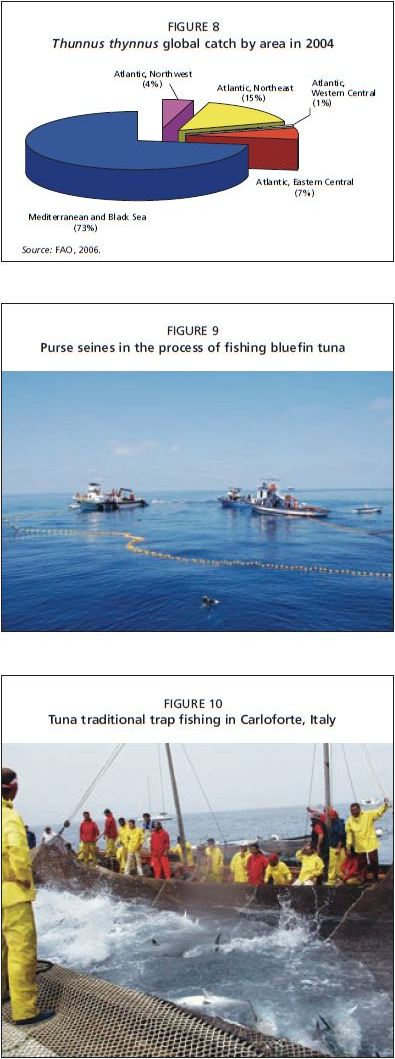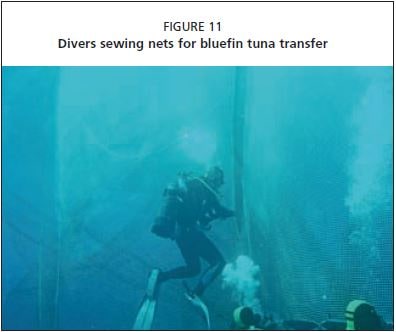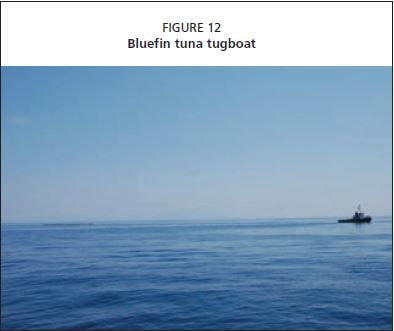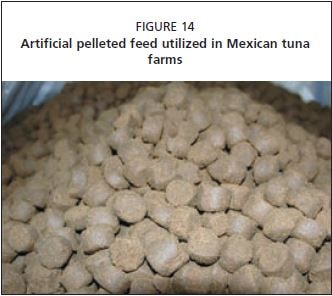CAPTURE-BASED AQUACULTURE
Thunnus thynnus is considered a capture-based aquaculture (CBA) species, as the farming activity is entirely based on the stocking of wildcaught individuals (Ottolenghi et al., 2004). Scientists at Kinki University, Japan, achieved the completion of the life cycle of the Pacific bluefin tuna (Thunnus orientalis) under controlled conditions after 32 years (Sawada et al., 2004).
For the Northern bluefin tuna (Thunnus thynnus), research on reproduction and the rearing of juveniles has been carried out, however the closure of its life cycle has not been achieved on a commercial-scale. Driven by the Japanese market, capturebased aquaculture has developed significantly.
Fishing techniques, season and catching size
For farming purposes, wild tunas are caught at different life cycle stages, ranging from juveniles of less than 8 kilograms to large adult specimens.
The capture system is the same for juveniles and adults, i.e. purse seines.
This modern and widely used fishing technique basically creates a “purse” net to entrap the school (Figure 9).
In the Mediterranean juveniles are mainly caught in the Adriatic Sea by Italian and Croatian purse seines at the end of spring and in early summer. Juveniles at about 15 kg in weight were also caught around September-October in the Tyrrhenian Sea and during the harvest season in the Balearic Islands (now prohibited by EC Regulation No. 643/2007 of 11/06/2007). The main fishing period in the Mediterranean runs from May to July.
There is strong cooperation among the purse seine vessels, often supported by aerial search. Small aircrafts or even helicopters are used to detect bluefin tuna schools (a practice now prohibited by ICCAT), however fish finders and sonar are largely used leaving little possibility for the fish to go undetected. A second capture
system is the traditional tuna trap which are a fixed gear anchored to the sea bottom, aimed at intercepting tuna in their migration paths (Figure 10).
Figure 8
Thunnus thynnus global catch by area in 2004 Atlantic, Northwest
Source: FAO, 2006.
Figure 9
Purse seines in the process of fishing bluefin tuna
Figure 10
Tuna traditional trap fishing in Carloforte, Italy

While these are still in use in some countries (e.g. Italy), they are loosing ground to the purse seiners, which are far more efficient in detecting and capturing the fish.
Aquaculture sites
Following the capture of wild bluefin tuna they are kept alive and carefully transferred to towing cages. The transfer action is a crucial activity as specimens may suffer severe stress that may lead to death. At present there is no efficient method to establish the fish biomass moving into the towing or farm cages making it rather difficult to determine the size and age composition of the fish. During the transfer process the fish are gently forced to move from the purse seine net to the towing cage usually by sewing the nets together (Figure 11). Divers often assist in this delicate operation and use underwater video cameras film as the film will eventually help in the discussions, often animated, between the fishermen and farmers in estimating the number and size of captured fish before a sale price is agreed. The industry considers the need to devise a better solution for determining the size and age composition of the captured fish destined for farming operation to be a priority. The lack of biometric information makes stock assessment and therefore, management and conservation of the bluefin tuna resource, rather difficult.
Once the tuna are all moved into the towing cages, tugboats are used to transport the fish from the fishing area to the on-growing or farm site (Figure 12). Towing speed does not usually exceed 1–1.5 knots in order to avoid excessive tuna mortality and to allow tuna to swim easily. However, such a low speed implies long transportation trips that may last days, weeks or even months which are further complicated by the need to adequately feed the confined fish. Mortality rates during transportation are usually quite low (1–2 percent) although there have been rare cases where all the fish have died.
In the Mediterranean, the companies engaged in this form of mariculture start stocking their tuna cages in late spring (May/June). This input season lasts for a couple of months (May/June or June/July), however, in the case of Croatia and Malta the season may extend to late summer (September). Mediterranean tuna farms largely use circular ring type open-sea floating net cages, either built locally or purchased from several large equipment manufacturers (e.g. Bridgestone, Corelsa, Fusion Marine). The size of the cages varies from 30–90 m in diameter, with net depths commonly ranging from 15 to 20–30 m. The industry mainly uses cages with a 50 m diameter and net depths varying according to sea location. The larger cages (i.e. 90 m in diameter) are mainly used by the Spanish operators while those in Croatia prefer smaller ones in terms of net depth, i.e. 13 m (FAO, 2005). Generally the weight of the
Figure 11
Divers sewing nets for bluefin tuna transfer

Figure 12
Bluefin tuna tugboat

stocked tuna is between 150–200 kilograms, however Croatian operations generally start their farming with smaller specimens weighing around 8–25 kilograms, while countries like Italy, Malta and Spain may even stock giant tunas weighing as much as 600 kilograms.
In the Mediterranean, there are mainly two types of cages used, those for “farming” and those for “fattening”. The “farming” cages are designed to contain generally small tuna specimens for long periods of time often more than 20 months. Most countries in the region do not retain the fish for such long periods and usually only confine the tuna for periods of 1–7 months. The “fattening” season which may extend to February and generally not beyond December/January is closely linked to the market demand/ opportunity. The fish may also be sold few days following capture as harvesting is often agreed beforehand between the producer and the fish trader.
Many Mediterranean countries, including Portugal, are currently farming Atlantic bluefin tuna: Croatia, Cyprus, Greece, Italy, the Libyan Arab Jamahiriya, Malta, Morocco, Spain, Tunisia and Turkey. Farms obtain fish from local fishing fleets as well as from vessels bearing other flags (e.g. Malta and Cyprus often obtain their fish supply entirely from foreign vessels). Croatia, France, Italy and Turkey have the highest number of vessels used in tuna fishing (FAO, 2005).
Table 1
Mediterranean countries farming bluefin tuna in 2001 and in 2007

Tuna farming in the Mediterranean area started in Andalusia, Spain, in 1985 and expanded in 1996 to Croatia, in 2000 to Malta and in 2001 to Italy (FAO, 2005). As of 2007, eleven Mediterranean countries (including Portugal) were involved in bluefin tuna farming (Table 1).
The driving force behind this rapid expansion has been the Japanese market. As a result, farmed products are produced to coincide with the optimal fat content demanded by the “sushi” and “sashimi” markets. The total Mediterranean tuna production derived from the farming activities is difficult to calculate as the initial cage stocking information, i.e. biomass and fish size, is only a rough estimate and any weight gain is generally kept confidential by the
farmers. For all ICCAT Contracting
Figure 13
Mediterranean bluefin tuna farming potential country capacity

Parties, bluefin tuna imports must be accompanied by the Bluefin Tuna Statistical Document (BTSD) and any country re-exporting the tuna must attach the original BTSD along with a re-export document. These documents are used to track the volume of farmed tuna exported to Japan which currently absorbs approximately 90 percent of total farmed tuna. In 2007 the potential capacity of all Mediterranean tuna farms authorized by ICCAT was 56 842 tonnes (Figure 13).
Bluefin tuna mortality rates during the fattening/farming period have been recorded at around 2 percent; however some countries (e.g. Spain and the Libyan Arab Jamahiriya) have reported higher mortalities during the first month the tuna are in cages. This is generally due to the long towing trip which stresses and weakens the fish just before they are moved into the farming cages. Bluefin tuna show great adaptiveness in captivity and so far no specific diseases have been recorded, nevertheless high mortalities may occur due to adverse environmental conditions such as strong currents or elevated water turbidity. Preliminary investigations on the suitability of a selected farm site can prevent and minimize such risks.
Feed
Bluefin tuna are fed mainly with a mixed diet composed principally of a variety of small pelagic species including sardine (Sardinella aurita), pilchard (Sardina pilchardus), round sardinella, herring (Clupea harengus), mackerel (Scomber japonicus), bogue (Boops boops) and squid (Illex sp.). The proportion and volume of the feed varies among the different countries and from farm to farm, with feed composition also based on the availability of the species generally used. Mediterranean countries engaged in the tuna farming obtain bait fish from locally fished stocks or from imports stocks from outside the region, with the latter usually representing the largest proportion of the fish used by the industry
Bluefin tuna are generally fed 1–3 times a day depending on the farm and country, with a mixture of defrosted bait fish. In most countries a scuba diver remains in the cage during feeding, and signals to stop the feeding when tuna are satiated. When the tuna are not fed ad libitum the daily feed input varies from 2–10 percent of the estimated tuna biomass and also depends on the water temperature and the fish size composition in the cage.
Without accurate initial length or weight measurements of the fish during cage farming, growth and feed conversion rates are only estimates. Under intensive farming conditions, growth, food intake and feed conversion rates have never been estimated accurately by farmers to avoid loosing the high value tuna as a result of the handling required to take such measurements (Aguado-Gimenez and Garcia–Garcia, 2005).
As for food intake, there is very little information available and it seems that overfeeding is a common practice among farmers. As the baitfish used varies in its nutritional qualities, it is not the quantity of baitfish supplied to the tuna that influence production, but the supply and quality of nutrients obtained from consuming them (Ottolenghi et al., 2004). Feed conversion ratios (FCR) are generally high around 15–20:1 for large specimens and 10–15:1 for smaller fish. Bluefin tuna maintain an unusually high body temperature and their constant movement implies a high energy demand (Graham and Dickson, 2001). As a result only a small fraction (5 percent) of the total energy input is used for body growth (Korsmeyer and Dewars, 2001).
Several studies on farmed-raised tuna have demonstrated that the tuna are generally in good health and pose no health risks to consumers. Nonetheless, management control procedures for the tuna industry must be developed to prevent any risk and to provide a qualitative fish health assessment for food quality and safety.
Appropriate freezing procedures decrease health risks in baitfish-fed tuna; however several studies have shown deterioration in baitfish quality after a few days to one month, depending on whether the fish have been chilled or frozen (e.g. the fatty compounds in pilchards readily oxidises and therefore careful handling procedures may need to be adopted) (Munday et al., 2003).
Considering the high volume of baitfish needed to feed tuna (2–10 percent daily of the BFT biomass farmed) there is an urgent need for research to develop artificial diets able to support a better feed conversion ratio and to ensure a better control over the quality of the fish produced (Ottolenghi et al., 2004). The absence of formulated feed is of concern to the industry, particularly in view of the current high FCR when using baitfish. Scientific evidence indicates that fish weaned on a formulated diet that replicates normal nutritional intakes will perform considerably better than those fed on baitfish. Furthermore, the availability of artificial feed would partly eliminate or at least ease farm logistics in terms of sourcing, purchasing, transporting and storing the feed, as well as eliminate health risks associated with the use of raw fish.
At present only limited research studies are being carried out on artificial feeds at the farm level. Following the Australian efforts
on Southern bluefin tuna (Thunnus maccoyii), encouraging results are being obtained in Mexico where the Pacific bluefin tuna (Thunnus orientalis) is cultured even though only a small percentage (<20 percent) of the tuna diet is made up of artificial feed (Figure 14). The main problems related to the use of the artificial feed have still to be overcome including high production costs and opposition/resistance from the Japanese market. Because the consumers mainly eat raw tuna meat, the taste of the flesh is important and does vary depending on the feeding strategy used by the farmers. For these reasons farmers prefer not to use pellets in order to avoid consumer rejection.
Figure 14
Artificial pelleted feed utilized in Mexican tuna farms

Environmental impact
At present, bluefin tuna capture-based aquaculture relies entirely on wild-caught seed, as the control of the full life cycle of the tuna at commercial-scale has yet to be achieved. This farming practice which is based on the removal of “seed” material from wild stocks clearly overlaps with the fisheries sector. In 2006 the SCRS has indicated that the spawning stock biomass (SSB) of the Atlantic bluefin tuna continues to decline while fishing mortality is increasing rapidly, particularly for large fish, and warned of a possible stock collapse. As a result in November 2006, ICCAT recommended establishing a multi-annual recovery plan (see section on Management).
It is well known that size and age composition of BFT destined for farming operations are not precisely determined and this affects the quality of available data for stock assessment. It is also apparent that the total allowable catch (TAC) set by ICCAT is not fully adhered to and is largely ineffective in controlling overall catch (ICCAT, 2006a). Therefore, there is a strong need to eliminate illegal fishing to ensure an efficient management of the fish stock.
As in all mariculture practices the grow-out component of BFT capture-based aquaculture poses concerns on the potential deterioration of the environment in the proximity of the farm site. Intensive fish farming generally generates a large amount of organic waste in the form of unconsumed feed, faecal and excretory matter. Such particulate matter can accumulate in the sediments below or close to the farm, causing an undesirable organic enrichment that may adversely affect the surrounding benthic community and, to a lesser extent, water quality (Ottolenghi et al., 2004). In the case of BFT farming the fish are generally maintained in cages for short periods of time (often around 7 months, with the exception of Croatia) which allows a rapid recovery of the ecosystem.
Farm site selection, as for all other marine aquaculture practices, is of critical importance to ensure the operational sustainability of tuna farming. The selection of an inappropriate site may result in oxygen depletion in the bottom water layers that may lead to the development of anoxic conditions in the sediment and production of toxic gases such as hydrogen sulphide. These phenomena will adversely affect benthic organism (Ottolenghi et al., 2004). Due to the biological nature of these large pelagic fish, farm sites need to be established in areas where there is a good circulation of well oxygenated water, a sufficient depth, etc. Careful site selection is therefore critical for successful and environmentally sustainable operation of tuna farms (Ottolenghi et. al, 2004).
As for feeding, the use of baitfish raises several concerns, including the relative impact of the harvest on the small pelagic resources, but also the high FCR (and consequently high discards) and the deterioration risk of the environmental as a result of the accumulation of uneaten bait fish on the sediment.
Socio-economic impacts
It is important to note that the tuna fattening industry has an economic impact in the Mediterranean area. There are huge financial investments, generally through major partnerships with Japanese companies, not only in the tuna farms but also in the capture fishery sector as a whole. This has, in some cases, resulted in modernization of entire fishing fleets, fitted with modern fish detection equipment, improved safety and crew comfort, and the use of new tug boats (e.g. Algeria built a whole new fleet). A modern 40–50 m length purse seine boat fitted with the latest equipment may costs around €3–4 million (US$4.4–5.9 million). During the BFT catching season the daily rent for a tug boat may amount to €3 000 or US$4 450 (excluding the cost of fuel as fish transfer trips may sometimes last for weeks). Furthermore, small airplanes are often used to detect fish, and some large operations had their own aircraft (now prohibited by EC Regulation No. 643/2007, 11/06/2007).
It is obvious that social benefits are often closely related to economic benefits, and the development of the BFT industry has created new job opportunities. At the same time, tuna capture-based aquaculture generates impacts and conflicts with other resource users such as the traditional tuna trap and longline operators. The activity of tug boats towing tuna cages disturbs the traditional longline fisheries in many countries (Italy, Malta, Tunisia) as well as reducing tuna catches. Bluefin tuna farmers in Croatia have caused problems and strong conflicts with tourism activities in the use of the coastal zone.
The BFT industry in the Mediterranean currently engages somewhere between 1 000–2 000 full-time workers, in addition to a considerable amount of casual labour during the farming season. The industry has also been characterised by the development of new skills, including teams of specialized divers, to properly handle harvesting operations, monitor fish mortality, moorings and inspection of cages, transfer of fish to the farm cages and appropriate killing procedures. Furthermore, tuna farms generally operate their own fleet of boats mainly for positioning the cages, bait transportation and feeding and for other routine farm activities.
Feeding constitutes one of the highest operating cost factors in tuna farms and one of the major concerns. Producers purchase bait fish from local fisheries but also through imports from other European Union (EU) countries and as far as the South and North American (mainly from the United States of America). The rising demand for small pelagic fish has had important effects on the market, e.g. sardine prices have doubled in 5 years (1998–2002) (De Mombrison and Guillaumie, 2003).
Market
Bluefin tuna prices have shown a decrease in the last 5 years. The cost/kg of BFT transferred live to the farms from the fishing sites is currently around €4 or US$5.9 (2007 data) depending on the specimen size, while in 2000 and 2002 the price paid to the fishermen was €8–9.5 (US$11.8–14). The value of BFT products sent to Japan has followed the same trend and the final income per kilogram of product exported sometimes barely cover farm expenses. In 2006 there was a significant shift in exports from fresh to frozen fish, also as a result of the high transportation costs. This has had several combined effects on market prices in Japan considering that this Asian country is almost the exclusive destination of farmed products. The high capacity to stock large amount of frozen tuna also allows traders to control the supply of the tuna into this lucrative market. In any case, it is evident that in 2006 the total fresh bluefin import trend into Japan have declined, lowering to 23 000 tonnes compared to 24 000 and 28 000 tonnes in 2005 and 2004, respectively (Table 2). According to data provided by the Globefish service of FAO the Japanese bluefin tuna business is worth ?42 000 million or US$354 million.
The final bluefin tuna products (mainly as sushi and sashimi) continue to show a positive trend in consumption, with prices depending on the quality of the individual fish specimen. A grading process determines the final destination of a bluefin tuna. This process, though apparently quick and easy to the uneducated eye, is a crucial factor for all the players in the trade network. By taking a thin core of flesh from the fish, the fisherman or wholesaler ascertains the fat and oil contents, appraises the colouring and outside appearance. In less than a minute and taking into consideration the market situation, the fish is tagged with a small slip of paper indicating its quality and final destination.
The main bluefin tuna consumption period in Japan falls during the many festivities in December that marks the end of the year. The whole tuna farming and fattening industry in the Mediterranean is based on such Japanese tradition. As the main tuna harvesting period is in the spring/summer months the fish are simply kept in cages for 6–7 months before they are harvested and exported to Japan to take advantage of the tuna price increase during such festivities.
Table 2
Fresh bluefin tuna imports into Japan (in tonnes)

Souce: FAO Globefish.
Management
The introduction of tuna farming activities into the Mediterranean resulted in rapid changes in capture fisheries, with the purse seine fishery becoming the most important provider of live tuna to the farming sector. Catch limits imposed by ICCAT have been in place for the Eastern Atlantic and Mediterranean management units since 1998. In 2002, the Commission fixed the 2002–2006 TAC at 32 000 tonnes. At the Fifteenth ICCAT Special Meeting held in November 2006, the 2007 TAC was set at 29 500 tonnes an amount that would gradually decrease to 25 500 tonnes in 2010. This TAC reduction is a part of a general ICCAT multi-annual recovery plan for bluefin tuna and includes a series of control measures such as closed seasons, minimum size and regulation of caging operations (ICCAT, 2006). The plan aimed partly to respond to the Commission’s Standing Committee on Research and Statistics 2006 stock assessment report that indicates that the BFT spawning stock biomass continues to decline while fishing mortality is rapidly increasing.
The SCRS nevertheless admits that the model used to assess the stock status has some limitations considering the increase uncertainties on current harvesting levels. In fact, as the main part of fish catch is destined for farming operations, the fish size and age composition is becoming more difficult to determine with the needed precision. Furthermore, it is believed that severe overfishing takes place and goes undetected hence reducing the efficiency of the TAC system in controlling overall tuna catches. It is clear that there is a strong component of illegal fishing and there are no effective policies against illegal, unregulated and unreported fishing (IUU) fully adopted and implemented by ICCAT's Member States.
The ICCAT attempt to protect the bluefin tuna spawning biomass and to reduce the juvenile catches by imposing a minimum size of 30 kilograms is an effort undermined, if not made useless, by the two exceptions included in the recommendation which allows fishing of 8 kilogram juveniles by (1) bait boats, trolling boats and pelagic trawlers in the Eastern Atlantic (mainly along the Spanish and French Atlantic coasts) for an amount of up to 2 950 tonnes in 2007 (about 368 750 individuals); and (2) boats that harvest in the Adriatic Sea for farming purposes. Furthermore, the ICCAT resolution also allows catching of individuals of <8 kilograms (and not <6.4 kg) for a total quantity not exceeding 200 tonnes. The situation is further complicated by the fact that several Mediterranean countries are currently not ICCAT members. The status of the Mediterranean bluefin tuna stock is in critical condition, and may face stock collapse unless dramatic actions take place at the regional level.